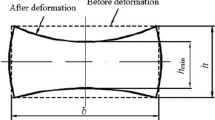Abstract
The bending radius (R) of the bending component is defined by the deflection (U) of the bending die in the tube free-bending process. The U-R relationship is the key factor to obtain the precise geometry size of the complex bending tubular components. Therefore, this study aims at proposing a new method to predict the U-R relationship for the arbitrary power hardening aluminum alloy (Al alloy) circular tube based on the U-R relationship of the reference material and the sensitivity analysis of material parameters, which may reduce many experimental works. In the current study, AA1100 alloy was set as the reference material, and the effects of each material parameter on the U-R relationship were investigated by carrying out the deformation and sensitivity analysis of the FEA simulation results. The results show that the bending radius increases with the decrease of elastic modulus (E), density (ρ), and strain-hardening exponent (n) and the increase of strength coefficient (K) and initial yield stress (σs), where σs has the greatest influence on the U-R relationship. Moreover, the U-R relationship prediction method for arbitrary power hardening Al alloy circular tube was presented based on the sensitivity analysis of the reference material. Finally, the bending tests of the AA6061-T6 tubes were carried out to prove the accuracy of the U-R relationship prediction method. The bending results show that the experimental U-R relationship of the AA6061-T6 tube was consistent with the predicted value, and the prediction method had good applicability to power hardening Al alloy circular tube.
Similar content being viewed by others
References
Murata M, Kuboki T (2015) CNC tube forming method for manufacturing flexibly and 3-dimensionally bent tubes. Springer, Berlin, pp 363–368
Guo X, Jin K, Wang H, Pei W, Ma F, Tao J (2016) Numerical simulations and experiments on fabricating bend pipes by push bending with local induction-heating process. Int J Adv Manuf Technol 84(9):2689–2695
Beulich N, Craighero P, Volk W (2017) FEA simulation of free-bending—a preforming step in the hydroforming process chain. J Phys Conf Ser 896:12–20
Murata M (1996) Effects of inclination of die and material of circular tube in MOS bending method. Trans Jpn Soc Mech Eng C 62:3669–3675
Guo X, Xiong H, Xu Y, Ma Y, El-Aty AA, Tao J, Jin K (2018) Free-bending process characteristics and forming process design of copper tubular components. Int J Adv Manuf Technol 8:1–17
Zhan M, Yang H, Huang L, Gu R (2006) Springback analysis of numerical control bending of thin-walled tube using numerical-analytic method. J Mater Process Technol 177(1):197–201
Gantner P (2008) The characterisation of the free-bending technique. Glasgow Caledonian University
Gantner P, Harrison DK, Silva AKM, Bauer H (2007) The development of a simulation model and the determination of the die control data for the free-bending technique. Proc Inst Mech Eng B J Eng Manuf 221(2):163–171
Gantner P, Bauer H, Harrison DK, Silva AKM (2005) Free-bending—a new bending technique in the hydroforming process chain. J Mater Process Technol 167(2):302–308
Ma Y, Xiong H, Wang H, Luo X, Jin K, Xu Y (2017) Simulation and experimental study on three dimensional free bending of complex space elbow. J Net Form Eng 9(2):20–26
Guo X, Ma Y, Chen W, Xiong H, Xu Y, El-Aty AA (2018) Simulation and experimental research of the free bending process of a spatial tube. J Mater Process Technol 255:137–149
Zhan M, Wang Y, Yang H, Long H (2016) An analytic model for tube bending springback considering different parameter variations of Ti-alloy tubes. J Mater Process Technol 236:123–137
Gantner P, Bauer H (2004) FEA—simulation of bending processes with LS-DYNA. 8th international LS-DYNA users conference 2:33–40
Zhou Y, Li P, Li M, Wang L, Sun S (2017) Residual stress and springback analysis for 304 stainless steel tubes in flexible-bending process. Int J Adv Manuf Technol 1:1–9
Li H, Yang H, Zhang Z, Li G, Liu N, Welo T (2014) Multiple instability-constrained tube bending limits. J Mater Process Technol 214(2):445–455
Zhan M, Huang T, Zhang P, Yang H (2014) Variation of Young’s modulus of high-strength TA18 tubes and its effects on forming quality of tubes by numerical control bending. Mater Des 53(3):809–815
Li H, Yang H, Song F, Zhan M, Li G (2012) Springback characterization and behaviors of high-strength Ti–3Al–2.5V tube in cold rotary draw bending. J Mater Process Technol 212(9):1973–1987
Saltelli A, Annoni P (2000) Sensitivity analysis. Wiley
Funding
The authors greatly acknowledge the financial support from the National Natural Science Foundation of China (Grant No.51875548), Jiangsu Province Science and Technology Program (Grant No. BE2016156), the Natural Science Foundation of Jiangsu Province (Grant No. BK20151469), the China Aviation Science Foundation (Grant No. 2016ZE52047), and the National Natural Science Foundation International (regional) cooperation and exchange project (Grant No.51711540301).
Author information
Authors and Affiliations
Corresponding author
Rights and permissions
About this article
Cite this article
Guo, X., Xiong, H., Xu, Y. et al. U-R relationship prediction method for aluminum alloy circular tube free-bending process based on sensitivity analysis of material parameters. Int J Adv Manuf Technol 99, 1967–1977 (2018). https://doi.org/10.1007/s00170-018-2614-5
Received:
Accepted:
Published:
Issue Date:
DOI: https://doi.org/10.1007/s00170-018-2614-5



